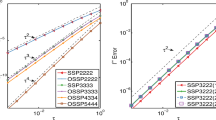Abstract
Strong stability preserving (SSP) high order Runge–Kutta time discretizations were developed for use with semi-discrete method of lines approximations of hyperbolic partial differential equations, and have proven useful in many other applications. These high order time discretization methods preserve the strong stability properties of first order explicit Euler time stepping. In this paper we analyze the SSP properties of Runge Kutta methods for the ordinary differential equation u t =Lu where L is a linear operator. We present optimal SSP Runge–Kutta methods as well as a bound on the optimal timestep restriction. Furthermore, we extend the class of SSP Runge–Kutta methods for linear operators to include the case of time dependent boundary conditions, or a time dependent forcing term.
Similar content being viewed by others
Reference--
Allen, M. B., and Isaacson, E. L. (1998). Numerical Analysis for Applied Science, John Wiley, New York.--
Butcher, J. C. (1987). The Numerical Analysis of Ordinary Differential Equations: Runge–Kutta and General Linear Methods, John Wiley, New York.--
Cockburn, B., and Shu, C.-W. (1989). TVB Runge–Kutta local projection discontinuous Galerkin finite element method for conservation laws II: General framework. Math. Comp. 52, 411-435.--
Gottlieb, S., and Shu, C.-W. (1998). Total variation diminishing Runge–Kutta schemes. Math. Comp. 67, 73-85.--
Gottlieb, S., Shu, C.-W., and Tadmor, E. (2001). Strong stability preserving high order time discretization methods. SIAM Rev. 43(1), 89-112.--
Gottlieb, D., and Orszag, S. A. (1977). Numerical Analysis of Spectral Methods: Theory and Applications, Society for Industrial and Applied Mathematics, Philadelphia.--
Gottlieb, D., and Tadmor, E. (1991). The CFL condition for spectral approximations to hyperbolic initial-boundary value problems. Math. Comp. 56, 565-588.--
Gustafsson, B., Kreiss, H. O., and Oliger, J. (1995). Time Dependent Problems and Difference Methods, John Wiley, New York.--
Harten, A. (1983). High resolution schemes for hyperbolic conservation laws. J. Comput. Phys. 49, 357-393.--
Kurganov, A., and Tadmor, E. (1999). New high-resolution schemes for nonlinear conservation laws and related convection-diffusion equations, UCLA CAM Report No. 99-16.--
Levy, D., and Tadmor, E. (1998). From semi-discrete to fully discrete: Stability of Runge–Kutta schemes by the energy method. SIAM Rev. 40, 40-73.--
Osher, S., and Chakravarthy, S. (1984). High resolution schemes and the entropy condition. SIAM J. Numer. Anal. 21, 955-984.--
Osher, S., and Tadmor, E. (1988). On the convergence of difference approximations to scalar conservation laws. Math. Comp. 50, 19-51.--
Shu, C.-W. (1988). Total-variation-diminishing time discretizations. SIAM J. Sci. Stat. Comput. 9, 1073-1084.--
Shu, C.-W., and Osher, S. (1988). Efficient implementation of essentially non-oscillatory shock-capturing schemes. J. Comput. Phys. 77, 439-471.--
Ruuth, S. J., and Spiteri, R. J. (2001). A New Class of Optimal High-Order Strong-Stability-Preserving Methods, Unpublished manuscript (under review).--
Ruuth, S. J., and Spiteri, R. J. (2001). Two Barriers on Strong Stability Preserving Time Discretization Methods, Unpublished manuscript (under review).--
Sweby, P. K. (1984). High resolution schemes using flux limiters for hyperbolic conservation laws. SIAM J. Numer. Anal. 21, 995-1011.--
Tadmor, E. (1997). Approximate solutions of nonlinear conservation laws. In Quarteroni, A. (ed.), Advanced Numerical Approximation of Nonlinear Hyperbolic Equations, Lectures Notes from CIME Course Cetraro, Italy, Lecture Notes in Mathematics 1697, Springer-Verlag, 1998, pp. 1-150.--
Verner, J. H. (1996). High-order explicit Runge–Kutta pairs with low stage order. Appl. Numer. Methods 22, 345-357.----
Author information
Authors and Affiliations
Rights and permissions
About this article
Cite this article
Gottlieb, S., Gottlieb, LA.J. Strong Stability Preserving Properties of Runge–Kutta Time Discretization Methods for Linear Constant Coefficient Operators. Journal of Scientific Computing 18, 83–109 (2003). https://doi.org/10.1023/A:1020338228736
Issue Date:
DOI: https://doi.org/10.1023/A:1020338228736



